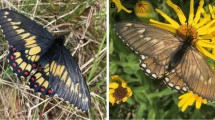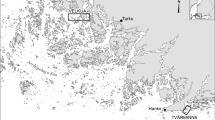Summary
House Finches (Carpodacus mexicanus), natives of western North America, have expanded their range in the eastern United States since their 1940 release in New York City. Range and the relation of House Finch population growth to the population dynamics of House Sparrows (Passer domesticus) and Purple Finches (Carpodacus purpureus) were examined, using data from the Breeding Bird Survey and the Christmas Bird Count. The House Finch population grew exponentially throughout its eastern range. Significant negative relationships in population density, relative to spatial and temporal control populations, were found between House Finches and House Sparrows in summer and winter, and between House Finches and Purple Finches in summer. Purple Finch and House Sparrow populations outside of the House Finch range appeared to have no effect on each other throughout the study. Neither changes in 74 weather variables, nor changes in forest, field or developed habitat explained the observed trends in population density. The results indicate that House Finches compete with these two species, but winter migration complicates the picture.
Similar content being viewed by others
References
Aldrich JW, Weske JS (1978) Origin and evolution of the eastern House Finch population. Auk 95:528–536
Bent AC (1958) Life histories of North American blackbirds, orioles, tanagers and allies. Smithsonian Institution, Washington, DC
Bent AC (1968) Life histories of North American cardinals, grosbeaks, buntings, towhees, finches, sparrows and allies, part 1. Smithsonian Institution, Washington, DC
Bock CE, Lepthien LW (1974) Winter patterns of bird species diversity and abundance in the United States and southern Canada. Am Birds 28:556–562
Bock CE, Lepthien LW (1976) Growth in the eastern House Finch population, 1962–1972. Am Birds 30:791–792
Bock CE, Root TL (1981) The Christmas Bird Count and avian ecology. Studies in Avian Biology 6:17–23
Bull J (1974) Birds of New York state. Doubleday, Garden City, NY
Bystrak D (1981) The North American Breeding Bird Survey. Studies in Avian Biology 6:34–41
Bystrak D, Robins CS (1978) Bird population trends detected by the Breeding Bird Survey. Pol Ecol Stud 3:131–143
Cant GB (1962) The House Finch in New York state. Kingbird 12:68–72
Connell JH (1961) The influence of interspecific competition and other factors on the distribution of the barnicle Chthamalus stellatus. Ecology 42:710–723
Connell JH (1980) Diversity and coevolution of competitors or the ghost of competition past. Oikos 35:131–138
Connell JH (1983) On the prevalance and relative importance of interspecific competition: evidence from field experiments. Am Nat 122:661–696
Conner EF, Simberloff D (1979) The assembly of communities: chance or competition? Ecology 60:1132–1140
Davis J (1973) Habitat preference and competition in wintering juncos and Golden-crowned Sparrows. Ecology 54:174–180
Drennan SR (1981) The Christmas Bird Count: an overlooked and underused sample. Studies in Avian Biology 6:24–29
Dunham AE (1980) An experimental study of interspecific competiton between the iguanid lizards Sceloporus merriami and Urosaurus orantus. Ecol Monogr 50:309–330
Elliot JJ, Arbib RS (1953) Origin and status of the House Finch in the eastern United States. Auk 70:31–37
Garcia EFJ (1983) An experimental test of competition for space between Blackcaps Sylvia atricappila and Garden Warblers Sylvia borin in the breeding season. J Anim Ecol 52:795–805
Kalanoski R (1975) Intra- and interspecific aggression in House Finches and House Sparrows. Condor 77:375–384
Katholi C (1967) House Finch in eastern United States. Redstart 34:71–74
Kricher JC (1983) Correlation between House Finch increase and House Sparrow decline. Am Birds 37:358–360
Martin AC, Zim HS, Nelson AL (1951) American wildlife and plants. Dover, New York
Moulton MP, Pimm SL (1983) The introduced Hawaiian avifauna: biogeographic evidence for competition. Am Nat 121:669–690
Mundinger PC, Hope S (1982) Expansion of the winter range of the House Finch: 1947–1979. Am Birds 36:347–353
Robbins CS, Van Velzen WT (1967) The Breeding Bird Survey 1966. US Fish Wildl Serv Spec Sci Rept: Wildl # 102
Robbins CS, Van Velzen WT (1969) The Breeding Bird Survey 1967 and 1968. US Fish Wildl Serv Spec Sci Rept: Wildl # 124
Salt GW (1952) The relation of metabolism to climate and distribution in three finches of the genus Carpodacus. Ecol Monogr 22:121–152
Schoener TW (1974) Competition and the form of habitat shift. Theor Popul Biol 6:265–307
Schoener TW (1983) Field experiments on interspecific competition. Am Nat 122:240–285
Snedecor GW, Corchran WG (1980) Statistical methods. 7th ed, Iowa State Univ, Press, Ames IA
Author information
Authors and Affiliations
Rights and permissions
About this article
Cite this article
Wootton, J.T. Interspecific competition between introduced house finch populations and two associated passerine species. Oecologia 71, 325–331 (1987). https://doi.org/10.1007/BF00378703
Received:
Issue Date:
DOI: https://doi.org/10.1007/BF00378703




